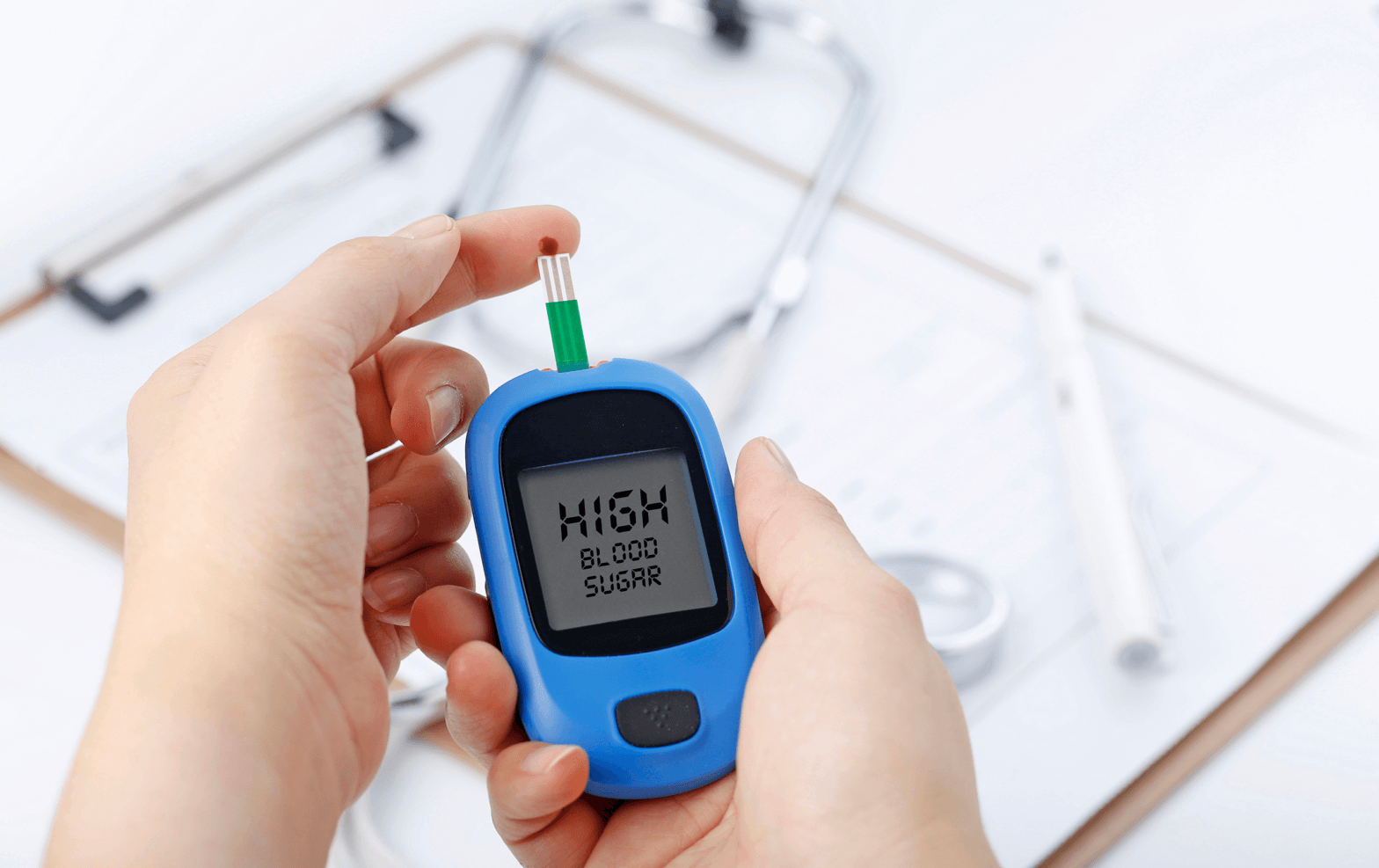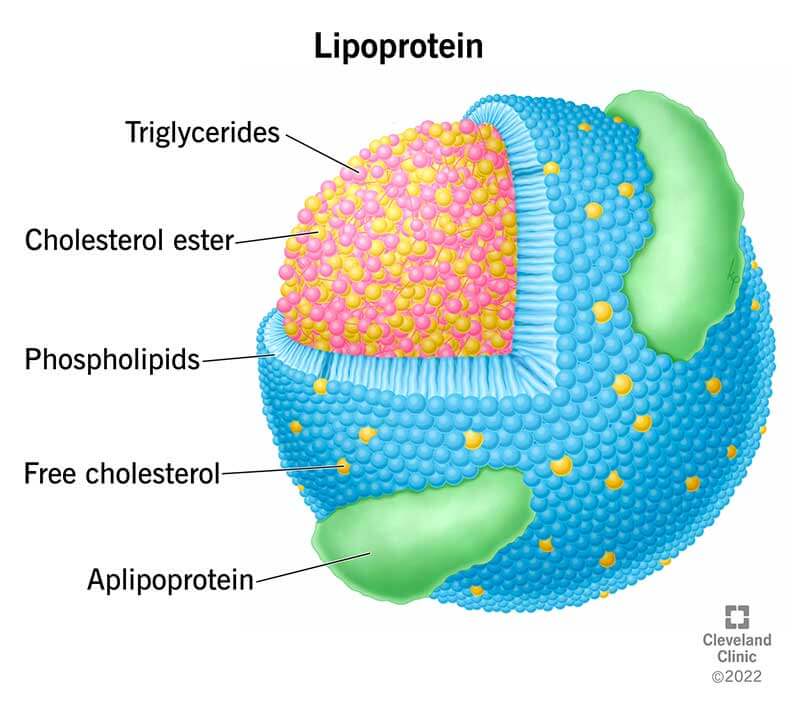Last updated: June 26, 2024
11 mins read
Key Takeaways:
- Apolipoprotein B (ApoB) is a protein found in atherogenic (artery-clogging) lipoproteins, such as LDL, VLDL, and IDL, and plays a critical role in lipid transport and metabolism.
- Apolipoproteins, including ApoB, are essential for transporting lipids in the body, but high levels of ApoB are associated with an increased risk of cardiovascular diseases.
- Regular monitoring and managing ApoB levels through diet, exercise, and possibly medication, are important for cardiovascular health.
Heart disease is the leading cause of death for men, women, and people of most racial and ethnic groups in the United States. One person dies every 33 seconds in the United States from cardiovascular disease. About 695,000 people in the United States died from heart disease in 2021—that’s 1 in every 5 deaths. [2]
What is ApoB?
Lipoproteins serve as intricate transport vehicles for lipids (fat) in the body, featuring a lipid core (consisting of fats such as cholesterol and triglycerides) enveloped by proteins, phospholipids, and free cholesterol.
There are different types of lipoproteins each with distinct compositions and functions. Examples include:
- High-density lipoprotein (HDL)
- Low-density lipoprotein (LDL)
- Intermediate-density lipoprotein (IDL)
- Very low-density lipoprotein (VLDL)
Their role is to navigate the circulatory and lymphatic systems. HDL, renowned as “good” cholesterol, prevents arterial plaque buildup, while elevated levels of others, particularly LDLs, pose cardiovascular risks.
“Lipoproteins: What They Are, Function & Importance.” Cleveland Clinic, 22 May 2022, my.clevelandclinic.org/health/articles/23229-lipoprotein.
Apolipoproteins (Apo), synthesized primarily in the liver, are integral components of lipoproteins, usually attached to their surface (as depicted in the image above). ApoB is generally associated with our “bad” lipoproteins such as VLDLs, IDLs, and LDL, whereas HDLs “good cholesterol” are associated with a different type of apolipoprotein, “ApoA1”.
Where apolipoproteins become useful is in indicating the abundance of all lipoprotein particles in the bloodstream. For example, ApoB is attached to the “bad” lipoproteins in a 1:1 ratio. They also play a key role in the movement of our lipoproteins around the circulatory system. By interacting with various enzymes and receptors involved in lipid metabolism APOB facilitates the uptake of cholesterol and other lipids by peripheral tissues.
What exactly is cholesterol?
Cholesterol is a waxy, fat-like substance that’s found in all the cells in your body. It is both produced by the body (primarily in the liver) and obtained from dietary sources, especially animal products like meat, dairy, and eggs. Cholesterol is an essential component for the body, necessary for cell membranes, bile production, and hormone synthesis.
The nomenclature surrounding lipoproteins and cholesterol can be confusing. Cholesterol is a type of lipid (fat) found in the blood and cells of the body. Lipoproteins, as explained above, are particles that transport cholesterol and other lipids through the bloodstream. HDLs (high density lipoproteins) are often called “good cholesterol” because they help remove excess cholesterol from the bloodstream, while LDLs are known as “bad cholesterol” because high levels can lead to plaque buildup in the arteries. Therefore, when we talk about HDL or LDL cholesterol, we’re actually referring to the cholesterol carried by the LDL lipoproteins.
Imbalanced cholesterol levels, especially elevated LDL cholesterol, heighten the risk of cardiovascular disease. Dietary choices, notably consumption of saturated and trans fats, are key influencers of cholesterol levels. Regular screening is advised to monitor cholesterol levels, with interventions typically encompassing lifestyle adjustments such as diet and exercise, complemented by medical treatments like statins when needed.
The nomenclature surrounding lipoproteins and cholesterol can be confusing. Cholesterol is a type of lipid (fat) found in the blood and cells of the body. Lipoproteins, as explained above, are particles that transport cholesterol and other lipids through the bloodstream. HDLs (high density lipoproteins) are often called “good cholesterol” because they help remove excess cholesterol from the bloodstream, while LDLs are known as “bad cholesterol” because high levels can lead to plaque buildup in the arteries. Therefore, when we talk about HDL or LDL cholesterol, we’re actually referring to the cholesterol carried by the LDL lipoproteins. [3]
Why is lipid transport by apolipoproteins important?
Lipids, including cholesterol and triglycerides, are vital for many bodily functions. However, lipids are not soluble in blood. Without apolipoproteins, lipids would remain insoluble in the bloodstream, leading to their accumulation and potential blockages in blood vessels. By forming complexes with lipids to create lipoproteins, apolipoproteins ensure efficient transport of lipids to various tissues and organs. Proper functioning and balance of apolipoproteins and lipoproteins are essential in preventing diseases. Dysregulation can lead to lipid disorders, such as hyperlipidemia (high levels of lipids in the blood), which is a major risk factor for cardiovascular diseases. Problems arise when there is an imbalance between the different types of cholesterol. High levels of LDL cholesterol, often referred to as “bad” cholesterol, can lead to atherosclerosis. Atherosclerosis is the buildup of plaques in the arteries, which can restrict blood flow and lead to heart attacks, strokes, and other cardiovascular issues. [4] It’s the balance between LDL and HDL, along with the overall level of cholesterol, that determines the risk of cholesterol-related health issues.
“What Is Atherosclerosis?” National Heart Lung and Blood Institute, U.S. Department of Health and Human Services, 24 Mar. 2022, www.nhlbi.nih.gov/health/atherosclerosis.
Why is ApoB considered “bad”?
ApoB is a primary component of LDL, the so-called “bad” cholesterol. High levels of LDL in the blood are a well-established risk factor for the development of atherosclerosis. ApoB is not only present in LDL but also in other atherogenic particles like VLDL and IDL. These lipoproteins are involved in transporting triglycerides and cholesterol in the blood and also contribute to atherosclerosis. Importantly, ApoB-containing lipoproteins have the ability to penetrate the arterial wall, where they deposit cholesterol and initiate the formation of plaques. This process, known as atherosclerosis, is a major contributor to the development of cardiovascular diseases. Hence, monitoring ApoB levels is crucial for assessing cardiovascular risk and implementing preventive measures. [5]
Numerous studies have shown that ApoB is a strong predictor of cardiovascular risk. [6] [7] [8] In some cases, ApoB has been found to be a better indicator than traditional lipid measures like total cholesterol or LDL cholesterol because it reflects the total particle number rather than just the cholesterol content. [9]
It’s important to note that while ApoB is associated with “bad” cholesterol, it is a necessary component of normal lipid metabolism. The “bad” designation primarily relates to its role in the context of atherogenic lipoproteins and their contribution to cardiovascular disease risk. Managing ApoB levels, typically through diet, lifestyle changes, and sometimes medication, can be an important part of reducing cardiovascular risk.
Interpretation and management of ApoB
To interpret your results, here are a few values that can be used to gauge your cardiovascular health. It is important to consult with your physician if you are concerned with any of your results.
- Low: < 50 mg/dL [10]
- Optimal: < 65 mg/dL [11]
- Normal: < 100 mg/dL [12]
- High risk of vascular disease: > 120 mg/dL [13]
According to the Cleveland Clinic, high ApoB may be a result of pregnancy, high cholesterol, or kidney issues while low ApoB may be present if you have sepsis, liver disease, malabsorption, or high estrogen levels. [14] Of course, there are a variety of other factors that may be associated with abnormal ApoB levels, so it is best to consult with a physician if you are concerned with your levels to determine the root cause and seek treatment.
If your ApoB levels are high, it is worth consulting your physician to see how you can manage your levels as underlying diseases may be at play. The SiPhox Heart Health Blueprint may also be a good option if you have elevated lipid levels or have a family history of poor cardiovascular health (see here: https://home.siphoxhealth.com/blueprints/heart-health). If you have slightly elevated levels, you can try:
- Engaging in at least 30 minutes of exercise each day [15]
- Limiting your intake of saturated fats [16] This can be done by avoiding foods like butter, coconut oil, cakes, biscuits, fatty cuts of meat, cheese, etc. [17]
- Avoiding tobacco products like cigarettes [18]
- Maintaining a healthy weight [19]
- Limiting trans fat intake [20]
- Consuming omega-3s (cold-water fish, walnuts, etc.), psyllium, and/or phytosterols (nuts, whole grains, etc.) [21]
- Following a Mediterranean diet [22]
- Increase your intake of foods rich in soluble fiber [23] such as wheat bran, psyllium seeds, cooked pinto beans, etc. (view the Soluble & Insoluble Fiber Foods List here)
Why is tracking your ApoB important?
Cardiovascular health is no joke. Several studies mentioned earlier in this guide have revealed just how vital ApoB is as a predictor for cardiovascular events. The good news is that LDL, HDL, ApoB, ApoA, and triglycerides are all modifiable. But the first step in monitoring your levels is to test your levels, and that’s where SiPhox Health comes in. The benefit of SiPhox Health is having the freedom to track such volatile biomarkers frequently, affordably, and conveniently from the comfort of your home. Want to see what your ApoB levels are right now? How about testing every week to see if limiting saturated fats or exercising are actually changing your levels? Or maybe you’re thinking of trying statins and want to monitor your levels to determine whether the prescribed dosage is right for you? With SiPhox Health, your health is in your hands. Check out our website to learn more about SiPhox Health’s Heart Health Blueprint.
Tracking your ApoB with SiPhox Health:
- At-home kit delivered to your home
- Fingerprick sample self-collection (low-pain, adjustable lancets)
- $295 one-time or subscribe to get $85 per test*
- Number of biomarkers included: 17 (7 cardiovascular markers including LDL, HDL, ApoA, ApoB, triglycerides, Lp(a), etc.)
- Heart Health Blueprint: Optimize for the lowest effective dose of lipid-lowering medication as needed.
- Sleep and activity tracking: Included, 200 devices supported
- 2-5 business days after collection
References





